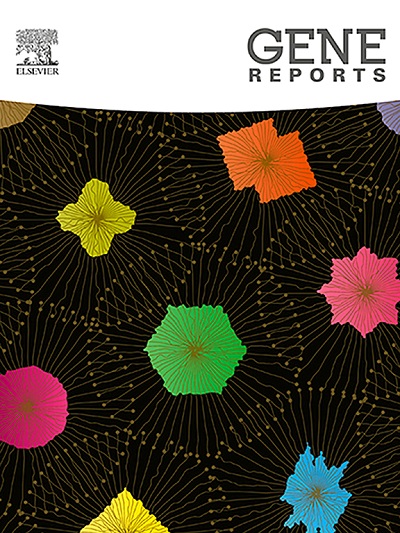Intra-segmental recombinations between avian and mammalian VP4 genotypes in Rotavirus alphagastroenteritidis
IF 1
Q4 GENETICS & HEREDITY
引用次数: 0
Abstract
Rotavirus alphagastroenteritidis (RVA), a pathogen causing acute gastroenteritis in young birds and mammals, possesses a genome of 11 segmented double-stranded RNAs, each of which is classified into genotypes. RVA has been divided into the avian and mammalian clusters as well as the basal group. Although the avian and mammalian clusters were considered to have evolved independently, genomic segment encoding viral protein 4 (VP4) of pheasant strain with genotype P[37] appeared to be transferred from mammalian cluster strain through reassortment. Here prototype sequences for all genotypes P[1]-P[58] of VP4 segment except for P[53] and P[54] retrieved from the International Nucleotide Sequence Database were analyzed to examine the possibility that P[37] was a product of intra-segmental recombinations between avian and mammalian cluster strains. In the sliding window analysis, different regions of P[37] appeared to have different relative similarities to avian and mammalian cluster strains. Using recombination detection programs, two regions of P[37] were identified to be derived from mammalian cluster strains and integrated into the background of avian cluster strain. These results were confirmed by phylogenetic analyses. Thus, even when genomic segments are not entirely compatible between strains, only compatible parts may be transferred through intra-segmental recombinations in RVA.
轮状病毒阿尔法肠胃炎病毒中禽类和哺乳动物 VP4 基因型之间的区段内重组
轮状病毒阿尔法肠胃炎病毒(RVA)是一种导致幼鸟和哺乳动物急性肠胃炎的病原体,其基因组由 11 条分段双链 RNA 组成,每条双链 RNA 又可分为不同的基因型。RVA 被分为禽类和哺乳动物群以及基础群。虽然鸟类和哺乳动物簇被认为是独立进化的,但基因型为 P[37] 的雉鸡毒株编码病毒蛋白 4(VP4)的基因组片段似乎是通过重配从哺乳动物簇毒株转移过来的。本文分析了从国际核苷酸序列数据库中检索到的除P[53]和P[54]之外的所有基因型P[1]-P[58]的VP4片段的原型序列,以研究P[37]是禽类和哺乳动物集群株之间片段内重组产物的可能性。在滑动窗口分析中,P[37]的不同区域似乎与禽类和哺乳动物集群菌株具有不同的相对相似性。利用重组检测程序,P[37]的两个区域被确定为来自哺乳动物集群菌株,并整合到了禽类集群菌株的背景中。系统进化分析证实了这些结果。因此,即使菌株之间的基因组片段并不完全兼容,在 RVA 中也可能只有兼容的部分通过片段内重组而转移。
本文章由计算机程序翻译,如有差异,请以英文原文为准。
求助全文
约1分钟内获得全文
求助全文
来源期刊

Gene Reports
Biochemistry, Genetics and Molecular Biology-Genetics
CiteScore
3.30
自引率
7.70%
发文量
246
审稿时长
49 days
期刊介绍:
Gene Reports publishes papers that focus on the regulation, expression, function and evolution of genes in all biological contexts, including all prokaryotic and eukaryotic organisms, as well as viruses. Gene Reports strives to be a very diverse journal and topics in all fields will be considered for publication. Although not limited to the following, some general topics include: DNA Organization, Replication & Evolution -Focus on genomic DNA (chromosomal organization, comparative genomics, DNA replication, DNA repair, mobile DNA, mitochondrial DNA, chloroplast DNA). Expression & Function - Focus on functional RNAs (microRNAs, tRNAs, rRNAs, mRNA splicing, alternative polyadenylation) Regulation - Focus on processes that mediate gene-read out (epigenetics, chromatin, histone code, transcription, translation, protein degradation). Cell Signaling - Focus on mechanisms that control information flow into the nucleus to control gene expression (kinase and phosphatase pathways controlled by extra-cellular ligands, Wnt, Notch, TGFbeta/BMPs, FGFs, IGFs etc.) Profiling of gene expression and genetic variation - Focus on high throughput approaches (e.g., DeepSeq, ChIP-Seq, Affymetrix microarrays, proteomics) that define gene regulatory circuitry, molecular pathways and protein/protein networks. Genetics - Focus on development in model organisms (e.g., mouse, frog, fruit fly, worm), human genetic variation, population genetics, as well as agricultural and veterinary genetics. Molecular Pathology & Regenerative Medicine - Focus on the deregulation of molecular processes in human diseases and mechanisms supporting regeneration of tissues through pluripotent or multipotent stem cells.
 求助内容:
求助内容: 应助结果提醒方式:
应助结果提醒方式:


